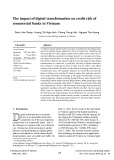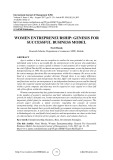
Citation: Zhang, M.; Huang, Z. The
Impact of Digital Transformation on
ESG Performance: The Role of Supply
Chain Resilience. Sustainability 2024,
16, 7621. https://doi.org/10.3390/
su16177621
Academic Editors: Katarzyna
Grondys, Oksana Seroka-Stolka
and Marta Kadłubek
Received: 19 July 2024
Revised: 23 August 2024
Accepted: 30 August 2024
Published: 3 September 2024
Copyright: © 2024 by the authors.
Licensee MDPI, Basel, Switzerland.
This article is an open access article
distributed under the terms and
conditions of the Creative Commons
Attribution (CC BY) license (https://
creativecommons.org/licenses/by/
4.0/).
sustainability
Article
The Impact of Digital Transformation on ESG Performance:
The Role of Supply Chain Resilience
Meixuan Zhang and Zongsheng Huang *
School of Economics and Management, Shanghai Maritime University, Shanghai 201306, China;
zhangmx0810@163.com
*Correspondence: zshuang@shmtu.edu.cn
Abstract: With the development of digital technologies, the impact of digital transformation on
corporate performance in environmental, social responsibility, and governance areas warrants further
research. This study aims to delve into how digital transformation may impact a company’s ESG per-
formance from the perspective of supply chain resilience. We collect non-financial listed companies in
China’s A-shares from 2009 to 2022 as research samples. The results show that digital transformation
can significantly improve the ESG performance. Digital transformation can enhance supply chain
resilience, namely by reducing supplier and customer concentration to improve a company’s ESG per-
formance. We also reveal that non-heavy polluting companies, high-tech companies, and companies
in the eastern regions are more sensitive to digital transformation in terms of ESG performance. This
paper contributes to examining the relationship between digital transformation and corporate ESG
performance, providing both a theoretical foundation and practical recommendations for guiding
companies in achieving digital transformation and improving their ESG performance.
Keywords: digital transformation; customer concentration; supplier concentration; supply chain
resilience; ESG
1. Introduction
As global environmental concerns, social inequality, and governance issues intensify,
the significance of corporate ESG (Environmental, Social, and Governance) performance
grows [
1
]. Originating from ethical investment practices, ESG now sets benchmarks for
corporate sustainability [
2
,
3
]. Notably, the 2019 European Green Deal has spurred climate-
focused legislation, such as the Carbon Border Adjustment Mechanism (CBAM) and the
Corporate Sustainability Reporting Directive (CSRD) in the EU, central to ESG disclosure.
Concurrently, the U.S. Sustainability Accounting Standards Board (SASB) has worked
to embed sustainability metrics into accounting standards. Similarly, China updated its
Corporate Governance Code for Listed Companies in September 2018 to require ESG and
social responsibility disclosures. These global movements align with the United Nations’
Sustainable Development Goals (SDGs), which aim for a sustainable and equitable world
by 2030, underscoring the urgent need for effective ESG strategies to drive economic and
social transformation toward sustainability. Consequently, how corporate strategies and
behaviors enhance their ESG levels has become a focal point in both academic and practical
realms, reflecting a critical intersection of business performance and societal expectations.
Amidst growing adherence to ESG principles and supportive policies, an increasing
number of companies are prioritizing ESG management. Environmentally, these firms are
reducing greenhouse gas emissions and boosting energy efficiency, with many investing
in ecological projects to lessen their operational impacts. Socially, they are enhancing
employee welfare through equitable pay and advancement opportunities. In governance,
improvements in board independence and diversity are increasing decision-making trans-
parency and accountability. Consequently, ESG reporting has become commonplace among
Sustainability 2024,16, 7621. https://doi.org/10.3390/su16177621 https://www.mdpi.com/journal/sustainability

Sustainability 2024,16, 7621 2 of 20
leading global companies, with disclosure rates climbing significantly: 79% for the N100
companies and 96% for the G250. This shift has also heightened focus on the environmen-
tal and social performance of supply chains, leading to stricter procurement standards
and compliance requirements that promote transparency, accountability, and sustainable
practices industry-wide.
Digital transformation is increasingly recognized as essential for enhancing opera-
tional efficiency and financial performance in businesses [
4
]. It involves the comprehensive
reinvention of business models, cultures, and market approaches through digital technolo-
gies. Parida et al. [
5
] noted that digitization improves access to operational resources and
reduces costs, fostering innovation. Current research has found that digital transforma-
tion significantly impacts various aspects, including corporate performance, innovation,
total factor productivity, and risk-taking levels [
6
–
9
]. Digital transformation has not only
reshaped business models and management mechanisms but has also significantly en-
hanced companies’ Environmental, Social, and Governance (ESG) performance. Vogler
and Eisenegger [
10
] highlighted its positive effects on corporate social responsibility and
reputation. By adopting advanced digital technologies, companies can more effectively
manage their resources and reduce energy consumption and emissions, thereby achiev-
ing significant progress in environmental protection [
11
,
12
]. Digital transformation can
also enhance ESG performance by improving production efficiency and fostering inno-
vation [
13
–
16
]. Although some scholars have examined the relationship between digital
transformation and corporate ESG performance, there are still some research gaps in this
area. These gaps include the following limitations: (1) existing studies often focus on the
observable outcomes of digital transformation on Environmental, Social, and Governance
(ESG) performance. However, there is a lack of detailed exploration into the internal mech-
anisms that influence these effects. Understanding these internal mechanisms is crucial for
a more comprehensive assessment of how digital transformation impacts ESG performance.
(2) There is a gap in research regarding how the effects of digital transformation on ESG
performance may vary based on different contextual factors. The differential impact has not
been adequately studied, which is important for offering more tailored recommendations.
Understanding how various circumstances influence the effectiveness of digital transfor-
mation in achieving ESG goals can provide companies with more nuanced guidance as
they plan and implement their digital development strategies.
In response to the above research gaps, this paper utilizes Chinese A-share listed
companies from 2009 to 2022 as a research sample. It investigates whether and how digital
transformation affects corporate ESG performance based on the diffusion of innovation
theory, resource-based view theory, and stakeholder theory. These theories suggest that
digital transformation significantly influences supply chain resilience. Hence, this study
explores whether digital transformation impacts corporate ESG performance through the
mediating factor of supply chain resilience. Additionally, it assesses how the effect of
digital transformation on ESG performance differs across regions, pollution levels, and
technological advancements. This approach not only broadens the research scope of digital
transformation but also furnishes valuable insights and guidance for companies aiming to
leverage digital strategies to advance their ESG objectives.
The innovative aspects and expected contributions of this study are as follows: (1) this
study focuses on examining the impact of digital transformation on corporate ESG per-
formance through the mediation of supply chain resilience. This perspective provides a
new dimension for understanding how digital transformation promotes corporate ESG
performance, enriching the understanding of its impact mechanisms. It emphasizes the role
of digital transformation in reshaping the external relationships of firms. Digitalization not
only alters internal operational models but also strengthens connections with suppliers, cus-
tomers, and other stakeholders. Attention to this external network can help firms achieve
better ESG outcomes; (2) the existing literature on the mediation effect of supply chain
resilience often considers it in general terms, and this study differentiates supply chain
resilience into two dimensions: reducing customer concentration and reducing supplier

Sustainability 2024,16, 7621 3 of 20
concentration. It analyzes how digital transformation enhances adaptability and resilience
in the face of market fluctuations, environmental changes, or other external pressures;
(3) by incorporating variations in the regional context, technological level, and pollution
intensity, this research provides a more comprehensive perspective on the differential
impact of digital transformation on corporate ESG performance. This approach aids firms
in developing more targeted digital and ESG strategies.
The paper is structured as follows: Section 2reviews the existing literature on digital
transformation, supply chain management, and ESG, developing the research hypotheses.
Section 3outlines the methodology, including data collection, models, and estimation
techniques. Section 4presents the analysis results, offering empirical evidence to support
the hypotheses. Finally, Section 5concludes the paper, discussing the implications of
the findings.
2. Literature Review and Hypotheses Development
2.1. Digital Transformation and Enterprise ESG Performance
The concept of ESG (Environmental, Social, and Governance) criteria was first explic-
itly introduced in 2004 through the United Nations Global Compact initiative. Since then,
it has gained increasing traction as companies worldwide recognize the importance of
aligning their operations with sustainability performance indicators [
17
,
18
]. Research on
ESG has been more established and accepted in Western countries, where a robust system
supports and integrates ESG practices into mainstream business operations.
In the United States, the trend toward sustainable investment has led to a surge in
ESG-related investment products, including Exchange-Traded Funds (ETFs), which have
grown significantly in both number and size. The European Union, too, has been proactive
in legislating ESG principles, exemplified by the Non-Financial Reporting Directive (NFRD).
This directive mandates the incorporation of ESG principles into legal frameworks, ensuring
systematic consideration of environmental, social, and governance issues. Furthermore, the
EU’s “Sustainable Finance Strategy” is designed to incentivize investors to direct capital
toward environmentally friendly technologies and sustainable business models.
China, with its commitment to carbon peaking and carbon neutrality targets, has seen
a rapid expansion of ESG practices. The Chinese government has ramped up its regulatory
efforts to oversee corporate non-financial performance in environmental and social spheres,
compelling businesses to prioritize and enhance their ESG performance for sustainable
high-quality growth.
Despite these advancements, the implementation of ESG policies encounters several
hurdles. One major challenge is the inconsistency and quality of ESG information disclosure.
A scarcity of quantitative data compromises transparency, comparability, and reliability.
Additionally, divergent methodologies employed by various rating agencies in evaluating
ESG performance, characterized by differing indicators, weights, and scopes, undermine
the uniformity of assessment outcomes [
19
]. Moreover, while academic research suggests a
positive correlation between strong ESG practices and financial performance, the long-term
financial returns of ESG investments are less tangible compared to short-term financial
metrics. This ambiguity can deter companies from fully committing to ESG initiatives [
20
].
Another issue pertains to the lack of a precise definition for ESG funds in China, which
results in few funds genuinely adopting professional ESG strategies, such as screening,
integration, and shareholder engagement activities.
Within the context of the digital economy, digital transformation is seen as a pivotal
strategy for companies to enhance their ESG performance. Existing research has examined
the impact of digital transformation on ESG performance based on various theoretical
frameworks, including agency theory [
16
], dynamic capabilities theory [
21
], and strategic
goals [
22
]. Some scholars argue that digital transformation positively influences ESG
performance, while others suggest that it has both positive and negative effects [
23
,
24
].
Despite these multiple perspectives, the causal relationship between digital transformation
and ESG performance remains unclear. Moreover, there is a lack of research focusing on

Sustainability 2024,16, 7621 4 of 20
the specific pathways through which digital transformation affects ESG performance. The
current literature primarily analyzes the impact of digital technology on environmental
indicators but lacks a systematic analysis based on the comprehensive nature of ESG.
Therefore, further research is needed to explore the impact of digital transformation on
ESG performance. This study aims to provide new empirical evidence on the influence
and mechanisms between digital transformation and ESG performance by drawing on the
diffusion of innovation theory, resource-based view theory, and stakeholder theory.
Drawing upon the diffusion of innovation theory, the proliferation of digital technolo-
gies spurs enterprises to adopt innovative management and operational paradigms, which
in turn elevates their overall ESG profile [25]. The essence of digital transformation lies in
its profound impact on both internal processes and external interactions. By integrating
advanced digital technologies, businesses can streamline their operations, improve effi-
ciency, and reduce resource waste and energy consumption [
26
]. This optimization not only
enhances a company’s green innovation capabilities but also strengthens its commitment
to social responsibility. Additionally, digital transformation can enable businesses to shift
toward service-centric models by leveraging innovative technologies. As companies adopt
a more service-oriented mindset, they place greater emphasis on product quality, brand
reputation, and external image [
9
]. Throughout this transformation, businesses are increas-
ingly likely to consider their social and environmental impacts, adopting practices and
strategies that align with ESG standards. These innovations not only boost a company’s
market competitiveness but also significantly enhance its overall ESG performance.
In line with the resource-based view theory, digital transformation can significantly
bolster ESG performance by optimizing the utilization and distribution of corporate re-
sources. The Resource-Based View (RBV) highlights that a firm’s sustained competitive
advantage primarily comes from its unique resources and capabilities, which must be
valuable, rare, inimitable, and supported by the organization [
27
]. During digital trans-
formation, resources such as information technology and data analytics are considered
strategic assets that can optimize resource allocation and boost total factor productivity.
Improving total factor productivity is crucial for firms to alleviate financing constraints and
invest more in ESG initiatives [
28
]. Additionally, digital tools offer more precise environ-
mental data analysis and risk forecasting capabilities, helping firms develop more effective
environmental management strategies [29] and thereby enhance their ESG performance.
Stakeholder theory posits that digital transformation enhances transparency and infor-
mation dissemination, catering to stakeholders’ demands for corporate social responsibility
and information accessibility, thus enriching the social and governance facets of corpo-
rate performance [
30
]. As digitalization advances, internal control information disclosure
becomes more robust, lending greater transparency to the supply chain. Stakeholders, en-
compassing investors, consumers, and regulatory authorities, gain easier access to monitor
a company’s ESG performance, promoting informational parity. This enhanced visibility
and external scrutiny motivate companies to prioritize ESG performance to align with
stakeholder expectations. Grounded in these observations, the following hypothesis is
put forth:
H1. Digital transformation can effectively improve the ESG performance of enterprises.
2.2. Digital Transformation and Supply Chain Resilience
The innovation and pilot application of industrial supply chains have entered a new
stage, a pattern of integrated development among large, medium, and small enterprises is
forming, autonomous control capabilities are being strengthened, and a preliminary supply
chain risk management mechanism has been established [
31
]. However, the modernization
of supply chains still faces a series of challenges. The rise of global trade protectionism
and the impact of the COVID-19 pandemic have posed severe challenges to global supply
chains. The relationships among participants in vertical industrial chains are not only
cooperative but also involve significant competitive pressures. This competition is mani-

Sustainability 2024,16, 7621 5 of 20
fested in opportunistic behaviors such as concealing information or actions between trading
partners [
32
], and also in the way that upstream and downstream trading entities leverage
their advantageous positions within the supply chain and strong bargaining power to
exert pressure on companies that centralize supply chain configurations [
33
]. Increased
external environmental uncertainty and systemic risks make centralized supply chains
more prone to production interruptions and severe economic losses [
34
]. Traditional supply
chain operations often suffer from slow market response, low levels of information sharing
between upstream and downstream, and high operational risks, severely limiting the
efficient operation of corporate supply chains. There is an urgent need to deeply integrate
with digital technology and move into a new phase of digital supply chains [35].
The progress of digital transformation has illuminated new pathways for bolstering
supply chain resilience. The “2021 China Enterprise Digital Transformation Index Report”
underscores that digitization has emerged as a pivotal enabler for Chinese firms to fortify
supply chain resilience amid the global health crisis. From an organizational resilience
standpoint, prior research demonstrates that digital transformation facilitates enhanced
agility. An examination of supply chain responsiveness across diverse enterprise scales
reveals that augmenting supply chain flexibility, resilience, and elasticity is critical for
cultivating novel green supply chain paradigms in a dual-circulation setting [
36
]. Studies
on the impact of digital transformation on supply chains have consistently highlighted that
digital technologies predominantly elevate supply chain efficiency by refining the precision
of supply–demand alignment and curtailing external transactional expenses [37].
Presently, scholars have engaged in extensive discourse on the interplay between digi-
tal transformation and supply chain resilience, with distinct emphases observed between
domestic and international academics. Domestic scholars tend to probe the theoretical
underpinnings of how digitalization impacts supply chain resilience, whereas international
researchers concentrate on the technical dimensions, such as the role of blockchain and
artificial intelligence in enhancing supply chain resilience. This paper synthesizes both
theoretical and technical perspectives to explore the inherent linkages between digital
transformation and supply chain resilience.
According to the diffusion of innovation theory, digital transformation greatly en-
hances supply chain resilience on multiple levels by introducing emerging technologies
and methods. The use of digital technologies enables real-time monitoring and forecasting,
allowing for the early identification of potential risks and challenges. This capability im-
proves the supply chain’s ability to foresee and respond to disruptions, thereby mitigating
the impact of risks on supply chain stability [
38
]. Concurrently, the widespread adoption
of digital technologies promotes greater information transparency and facilitates a more
efficient flow of resources and information among supply chain participants [
39
]. This
optimized configuration not only increases resource utilization efficiency but also enhances
coordination and reduces information delays, improving overall supply chain coherence
and flexibility. Ultimately, the broad dissemination of technological innovations transforms
supply chain management into a more intelligent and adaptable system, significantly
boosting overall supply chain resilience.
From the resource-based view theory, digital development provides a resource advan-
tage for enterprises [
40
]. Digital transformation enhances key resources in supply chain
management by introducing advanced technologies. These technologies improve infor-
mation processing capabilities, allowing the supply chain to acquire and analyze data in
real time. This enhancement boosts the supply chain’s ability to forecast market dynamics
and potential risks. With greater information transparency and processing efficiency, the
supply chain can respond more swiftly and accurately to changes, optimizing resource
allocation and scheduling. This optimization enables the supply chain to demonstrate
greater adaptability and stability in the face of various internal and external disruptions,
leading to more effective resource utilization. Consequently, digital transformation not only
improves overall supply chain efficiency and coordination but also strengthens resilience
in complex and uncertain environments.


























